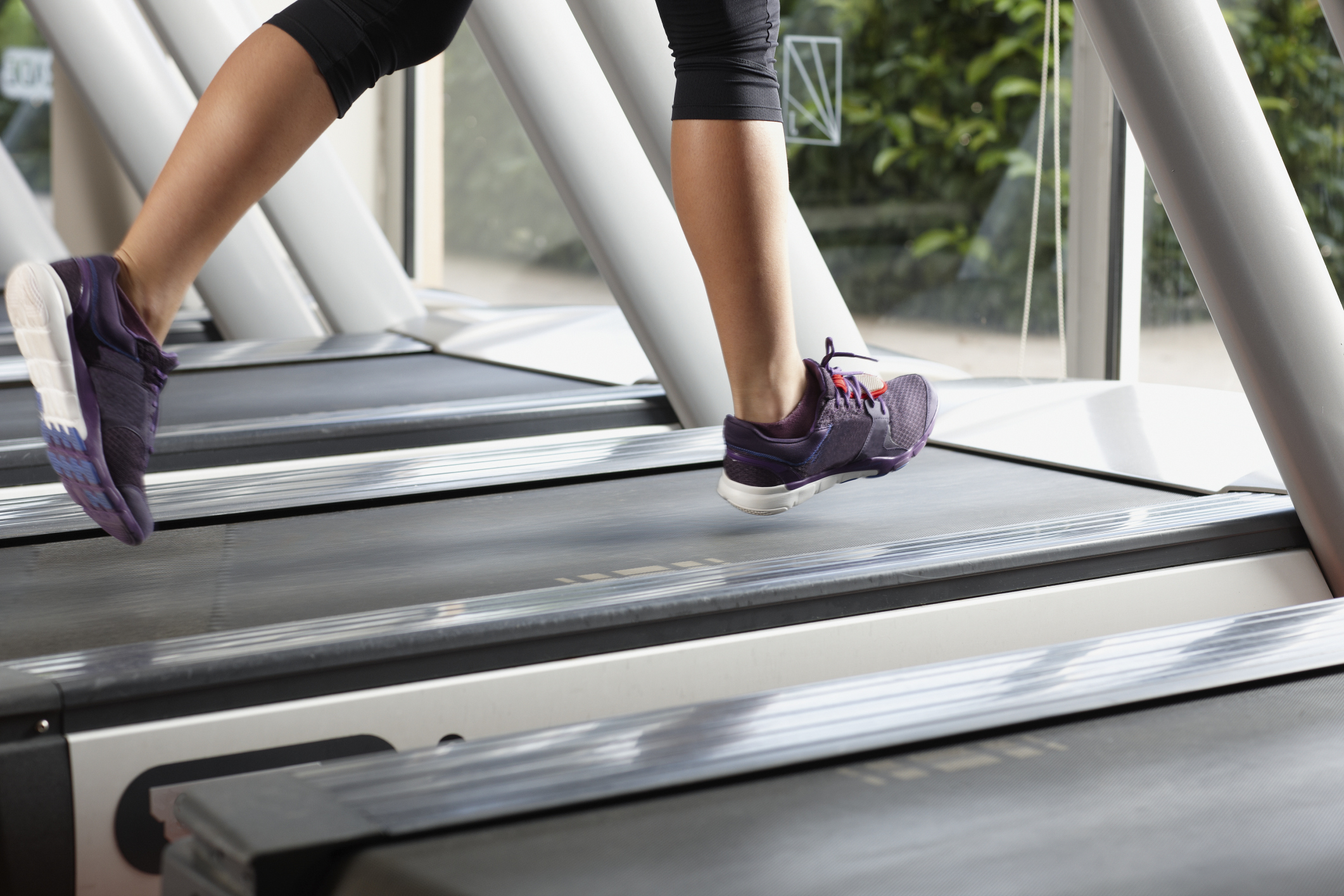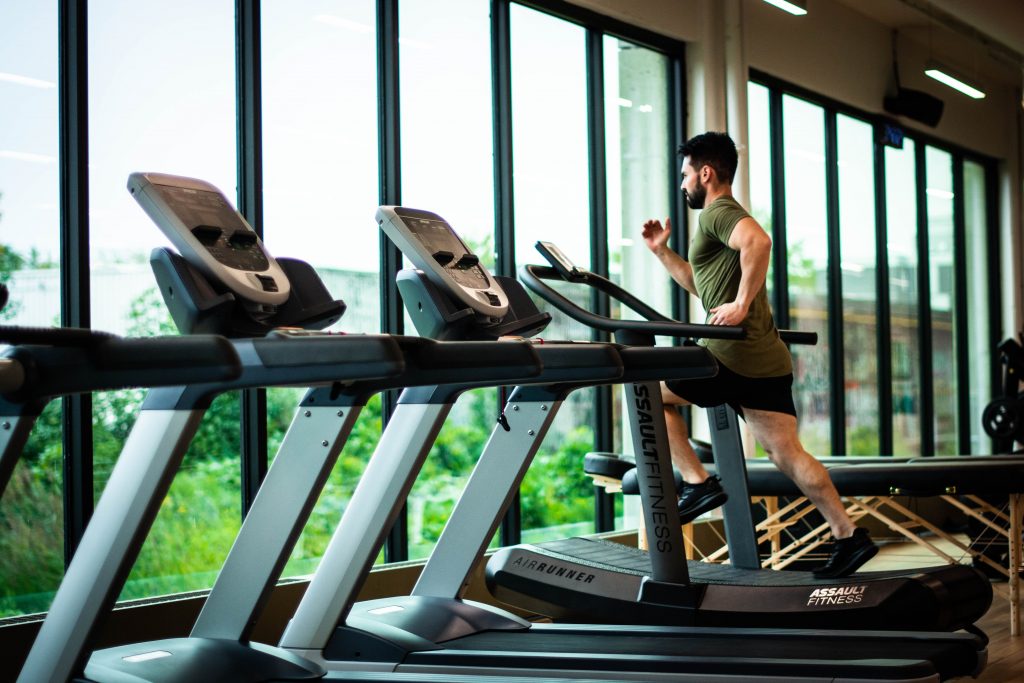If you’ve ever experienced dizziness after using a treadmill, you know just how frustrating and disorienting it can be. Don’t worry, though – we’re here to help! In this article, we’ll provide you with some useful tips and strategies to help you put an end to that post-workout dizziness. Whether you’re a beginner or a seasoned gym-goer, these techniques will surely come in handy. So, get ready to step off the treadmill feeling balanced and energized, rather than dizzy and disoriented. Let’s dive in!
:max_bytes(150000):strip_icc()/GettyImages-564725065-57d1cff65f9b5829f444d69c.jpg)
This image is property of www.verywellfit.com.
Common Causes of Dizziness After Using Treadmill
Dehydration
One common cause of dizziness after using a treadmill is dehydration. When you exercise, especially on a treadmill, your body sweats to regulate its temperature. This sweat loss can lead to dehydration, which in turn can cause dizziness. It is essential to stay hydrated before, during, and after your treadmill workout to prevent this symptom.
Incorrect Exercise Form
Another potential cause of dizziness is improper exercise form while using a treadmill. If you are not maintaining correct posture or positioning, it can strain your body, leading to dizziness. It is crucial to follow proper exercise techniques, such as keeping your head aligned with your spine and maintaining a steady stride, to avoid dizziness associated with incorrect form.
Low Blood Sugar
Low blood sugar levels, especially for individuals with diabetes or those who have not eaten before their workout, can contribute to dizziness after using a treadmill. When your body lacks glucose, which provides energy to your brain, you may experience dizziness. To prevent low blood sugar, it is advisable to eat a balanced meal or snack before your treadmill workout.
Low Blood Pressure
Dizziness can also be a result of low blood pressure, commonly known as hypotension. While exercise generally leads to an increase in blood pressure, some individuals may experience a temporary drop in blood pressure during or after a treadmill workout. This sudden change can cause dizziness. If you have a history of low blood pressure, it is recommended to monitor your levels and make adjustments to your exercise routine if necessary.
Overexertion
Pushing yourself too hard during a treadmill workout can lead to overexertion, causing dizziness. When you exercise intensely without allowing your body enough time to recover, it can place excessive strain on your cardiovascular system, resulting in dizziness. It is important to listen to your body’s signals and take breaks or adjust your workout intensity accordingly.
Preventing Dizziness While Using Treadmill
Stay Hydrated
To avoid dehydration-related dizziness, it is crucial to stay hydrated before, during, and after your treadmill workout. Drink an adequate amount of water throughout the day and consider carrying a water bottle with you during your workout. Aim to consume fluids, such as water or sports drinks, to replenish the lost electrolytes.
Maintain Proper Exercise Form
Proper exercise form is essential to prevent dizziness during and after a treadmill workout. Ensure that you are maintaining alignment while running or walking on the treadmill. Keep your head straight, shoulders relaxed, and arms at a comfortable position. Avoid leaning forward or slouching, as it can strain your body and potentially lead to dizziness.
Eat a Balanced Meal Beforehand
To prevent low blood sugar-induced dizziness, it is recommended to eat a balanced meal or snack before your treadmill workout. Include carbohydrates, protein, and healthy fats in your pre-workout meal to provide your body with the necessary energy. Avoid exercising on an empty stomach, especially if you have diabetes or experience frequent low blood sugar episodes.
Warm-Up and Cool Down
To ensure a smooth transition into and out of your treadmill workout, incorporate proper warm-up and cool-down routines. Start your workout with a few minutes of light cardio exercises, such as jogging in place or brisk walking, to gradually increase your heart rate and warm up your muscles. Similarly, dedicate a few minutes at the end of your workout to gradually decrease your intensity and allow your body to cool down.
Adjust Treadmill Speed and Incline Gradually
To prevent sudden drops in blood pressure or overexertion, it is important to adjust your treadmill speed and incline gradually. Start with a comfortable pace and increase it gradually as your body adjusts to the workout. Similarly, avoid setting the incline at a steep level right from the beginning. Gradual adjustments will give your body time to adapt, decreasing the chances of dizziness.

This image is property of i.ytimg.com.
Recommended Duration and Intensity for Treadmill Usage
Gradually Increase Duration and Intensity
When using a treadmill, it is recommended to gradually increase both the duration and intensity of your workouts. This approach allows your body to adapt to the demands of exercise and reduces the risk of dizziness. Begin with shorter sessions and a moderate intensity level, then slowly increase the time and intensity as your fitness level improves.
Consult with a Fitness Professional
If you are unsure about the appropriate duration and intensity for your treadmill workouts, it is advisable to consult with a fitness professional. They can assess your current fitness level, help set realistic goals, and guide you in designing a suitable treadmill workout program. Following their expert advice can help prevent dizziness and optimize your fitness journey.
Listen to Your Body’s Signals
One of the most important aspects of determining the duration and intensity of your treadmill usage is listening to your body. Pay attention to how you feel during and after your workouts. If you experience excessive fatigue, dizziness, or other discomforting symptoms, it may be a sign that you need to adjust your workout routine. Always prioritize your well-being and make necessary modifications accordingly.
Use Heart Rate Monitoring
An effective way to gauge the intensity of your treadmill workouts is by monitoring your heart rate. Use a heart rate monitor or the built-in heart rate tracking feature on the treadmill to ensure you are exercising within your target heart rate zone. This zone is typically calculated based on your age and fitness level. Maintaining an appropriate heart rate will help prevent overexertion and associated dizziness.
Consider Interval Training
Interval training, which involves alternating between high-intensity and low-intensity intervals, can be an effective way to improve fitness and prevent dizziness on a treadmill. By incorporating short bursts of intense exercise followed by periods of active recovery, you can challenge your cardiovascular system while still allowing for adequate rest. Interval training can help you gradually increase your endurance and reduce the likelihood of dizziness.
Techniques to Manage Dizziness During Treadmill Workout
Stop and Rest
If you start feeling dizzy during a treadmill workout, it is important to stop and rest immediately. Continuing to exercise in a dizzy state can increase the risk of accidents or falls. Find a safe place to sit or lie down, take deep breaths, and give your body time to recover. It is better to interrupt your workout temporarily than to ignore the dizziness and potentially compromise your safety.
Practice Deep Breathing
Deep breathing exercises can help manage dizziness during a treadmill workout. When you feel lightheaded, focus on slow, deep breaths. Inhale deeply through your nose, allowing your abdomen to expand, and exhale slowly through your mouth. Deep breathing improves oxygen flow to your brain and can help alleviate dizziness.
Focus on a Fixed Point
To counteract dizziness, fixating your gaze on a stable and non-moving point can be helpful. Choose a point in front of you, such as a spot on the wall or a stationary object, and concentrate on it while you exercise. This technique can provide a visual reference and help stabilize your balance, reducing the sensations of dizziness.
Reduce Treadmill Speed and Incline
If you experience dizziness during a treadmill workout, try reducing the speed and incline settings. Slowing down the pace and decreasing the incline level can ease the physical strain on your body and alleviate dizziness symptoms. Find a speed and incline that feels comfortable and gradually increase them as you regain stability.
Use a Fan or Air Ventilation
Improving the airflow around you can help manage dizziness during a treadmill workout. Set up a fan near your treadmill or ensure there is proper ventilation in the room. The cool air circulation can help regulate your body temperature and reduce the likelihood of experiencing dizziness caused by overheating.

This image is property of cdn.shopifycdn.net.
Supplemental Measures to Reduce Dizziness
Address Underlying Health Conditions
If you frequently experience dizziness while using a treadmill, it is essential to address any underlying health conditions that may contribute to this symptom. Consult with a healthcare professional to discuss your dizziness episodes and undergo any necessary medical evaluations. They can provide guidance on managing or treating any conditions that may be affecting your treadmill workouts.
Improve Cardiovascular Fitness
Strengthening your cardiovascular system through regular exercise can help reduce dizziness during treadmill workouts. Engaging in other forms of aerobic exercise, such as cycling or swimming, can improve your overall fitness and cardiovascular endurance. By gradually building your cardiovascular fitness, you may experience fewer instances of dizziness while using a treadmill.
Incorporate Balance and Coordination Exercises
Working on your balance and coordination through specific exercises can enhance your body’s ability to maintain stability during treadmill workouts. Incorporate activities such as yoga, tai chi, or balance training exercises into your fitness routine. These exercises can improve proprioception and strengthen the muscles responsible for balance, reducing the risk of dizziness.
Avoid Rapid Head Movements
Sudden or rapid head movements can trigger dizziness in some individuals, particularly those with certain vestibular conditions. When using a treadmill, avoid excessive head movements, such as looking around rapidly or changing your gaze from the front to the sides frequently. Keeping your head steady and focused ahead can help minimize dizziness episodes.
Consider Using Acupressure Bands
Acupressure bands, often used to relieve nausea and motion sickness, may offer relief for some individuals experiencing treadmill-induced dizziness. These bands apply pressure to specific points on the wrist believed to help reduce dizziness and discomfort. Consult with a healthcare professional or try acupressure bands to see if they alleviate your symptoms.
Potential Warning Signs That Require Medical Attention
Severe or Prolonged Dizziness
If you experience severe or prolonged dizziness during or after a treadmill workout, it is important to seek medical attention. This could indicate an underlying medical condition that requires assessment and treatment. A healthcare professional can evaluate your symptoms, perform diagnostic tests if necessary, and provide appropriate guidance for your specific situation.
Chest Pain or Irregular Heartbeat
If you experience chest pain or irregular heartbeat in addition to dizziness during or after a treadmill workout, it is crucial to seek immediate medical attention. These symptoms may signal a cardiac issue, such as angina or arrhythmia, which should be evaluated by a healthcare professional promptly. Do not ignore these warning signs, as they could be indicative of a serious medical condition.
Shortness of Breath
Shortness of breath that accompanies dizziness during a treadmill workout warrants medical attention. It may indicate an issue with respiratory function or compromised cardiovascular health. A healthcare professional can assess your breathing patterns, perform diagnostic tests if necessary, and recommend appropriate treatment or interventions.
Fainting Spells
If you experience fainting spells or near-fainting episodes while using a treadmill, it is vital to consult with a healthcare professional. Fainting can be caused by various factors, including underlying cardiac issues or problems with blood flow to the brain. A thorough evaluation is necessary to identify the cause and implement appropriate strategies to prevent future incidents.
Persistent Headaches
If you frequently experience debilitating headaches during or after treadmill workouts, it is advisable to seek medical attention. Persistent headaches coupled with dizziness can be a symptom of various conditions, including migraines or underlying cardiovascular issues. A healthcare professional can assess your headaches, determine their cause, and recommend suitable treatments or preventive measures.

This image is property of img.livestrong.com.
Adjusting Treadmill Settings for Personal Comfort and Safety
Optimal Speed and Incline Levels
To ensure your comfort and safety while using a treadmill, it is important to adjust the speed and incline levels according to your abilities and goals. Start at a pace and incline that feels comfortable for you and gradually increase them as your fitness level improves. Finding the right balance allows you to have an enjoyable workout without compromising your safety or inviting dizziness.
Using Handrails Appropriately
The handrails on a treadmill can provide stability and support, especially for individuals who feel unsteady while walking or running. However, it is important to use the handrails appropriately to maintain proper form and avoid excessive reliance on them. Lightly rest your fingertips on the handrails rather than gripping them tightly, as gripping can alter your posture and contribute to dizziness.
Proper Footwear and Shoe Grip
Wearing appropriate footwear with sufficient grip is essential for safety and minimizing the risk of slipping or losing balance on the treadmill. Choose shoes specifically designed for running or walking, as they offer better cushioning and traction. Avoid exercising in shoes with worn-out soles, as they can increase the likelihood of imbalance and dizziness.
Positioning and Posture
Maintaining proper positioning and posture on the treadmill can significantly affect your comfort and stability. Stand tall with your head aligned with your spine, shoulders relaxed, and core engaged. Avoid leaning forward or backward, as it can disrupt your balance and potentially lead to dizziness. Focus on maintaining a neutral position throughout your treadmill workout.
Psychological Factors
Psychological factors, such as anxiety or fear of falling, can contribute to dizziness while using a treadmill. It is important to address these concerns and develop strategies to manage them. Consider working with a mental health professional who can help you overcome psychological barriers and improve your confidence while using the treadmill.
Importance of Regular Exercise and Consistency
Gradual Adaptation to Exercise
Regular exercise, including treadmill usage, allows your body to gradually adapt and become more efficient over time. By consistently challenging yourself and slowly increasing intensity, duration, and frequency, you can build cardiovascular endurance and reduce the likelihood of dizziness. Remember to start with a level that matches your current fitness and gradually progress to more challenging workouts.
Establishing a Routine
Consistency is key when it comes to reaping the benefits of exercise and preventing dizziness. Establishing a regular treadmill workout routine helps make exercise a habit and allows your body to adjust and recover effectively. Consider scheduling dedicated times for your treadmill workouts and stick to them as much as possible. Consistency will not only improve your fitness but also reduce the risk of dizziness.
Benefits of Aerobic Exercise
Regular aerobic exercise, such as using a treadmill, offers numerous health benefits beyond cardiovascular endurance. It improves lung capacity, strengthens muscles, aids in weight management, enhances mood, and reduces the risk of chronic diseases. By incorporating treadmill workouts into your routine, you are not only preventing dizziness but also optimizing your overall health and well-being.
Positive Impact on Mental Health
Exercise, including treadmill workouts, has a positive impact on mental health. Physical activity releases endorphins, the feel-good hormones, which can boost your mood and alleviate symptoms of stress, anxiety, and depression. By making treadmill exercise a regular part of your routine, you are promoting mental well-being and potentially reducing episodes of dizziness associated with psychological factors.
Building Endurance
Consistent treadmill workouts provide opportunities to build endurance gradually. As your body becomes more accustomed to exercise, you will notice improvements in your stamina and ability to sustain longer workouts. Building endurance is crucial for preventing dizziness, as it allows your body to handle increased physical demands without becoming overwhelmed or fatigued.

This image is property of endurancefam.com.
Common Mistakes to Avoid While Using Treadmill
Skipping Warm-Up and Cool Down
Skipping warm-up and cool-down exercises is a common mistake that can lead to dizziness. Warm-up exercises prepare your body for exercise by gradually increasing your heart rate and blood flow. Similarly, cooling down after a workout allows your body to return to its pre-exercise state gradually. Skipping these important components of your workout can increase the risk of dizziness.
Overlooking Safety Measures
Neglecting safety measures while using a treadmill can have serious consequences, including injuries and dizziness. Always familiarize yourself with the safety features and guidelines of the specific treadmill you are using. Additionally, ensure that the space around the treadmill is clear of obstacles to prevent tripping or falling. Prioritize your safety to avoid any potential risks.
Pushing Beyond Limits
Pushing yourself too hard or beyond your physical capabilities is a common mistake that can result in dizziness. It is important to listen to your body and know your limits. Overexertion can lead to fatigue, dehydration, and an increased risk of dizziness. Gradually increase the intensity and duration of your treadmill workout to avoid pushing too hard and compromising your well-being.
Neglecting Proper Hydration
Inadequate hydration is a mistake that can contribute to dizziness during and after a treadmill workout. When you exercise, your body loses fluids through sweat, leading to dehydration. It is crucial to drink enough water before, during, and after your workout to maintain proper hydration levels. Neglecting hydration can increase the likelihood of dizziness and other symptoms.
Inadequate Rest and Recovery
Rest and recovery are crucial elements of any workout routine. Giving your body enough time to rest and repair itself is essential for preventing dizziness and overexertion. Avoid exercising every day without allowing for proper recovery periods. Listen to your body, schedule rest days, and prioritize quality sleep to support your overall well-being and prevent workout-induced dizziness.
Conclusion
To have a safe and enjoyable treadmill experience, it is important to follow best practices and make necessary adjustments. Dizziness after using a treadmill can be caused by factors such as dehydration, incorrect exercise form, low blood sugar, low blood pressure, and overexertion. By staying hydrated, maintaining proper exercise form, eating a balanced meal beforehand, warming up and cooling down, and gradually adjusting treadmill settings, you can prevent dizziness. Additionally, managing dizziness during a treadmill workout involves stopping and resting, practicing deep breathing, focusing on a fixed point, reducing speed and incline, and using a fan for airflow. Supplemental measures such as addressing underlying health conditions, improving cardiovascular fitness, incorporating balance and coordination exercises, avoiding rapid head movements, and considering acupressure bands can also help reduce dizziness. It is important to recognize potential warning signs that may require medical attention, adjust treadmill settings for personal comfort and safety, understand the importance of regular exercise and consistency, and avoid common mistakes. By following these guidelines, you can have a safe and successful treadmill workout while minimizing the risk of dizziness. Remember to take the necessary precautions, listen to your body, and enjoy the benefits of regular exercise on your fitness journey. Stay consistent, stay fit!

